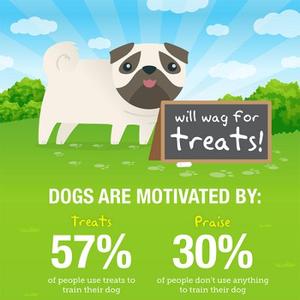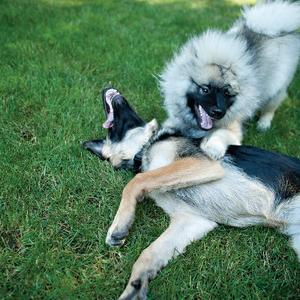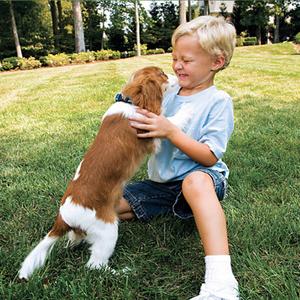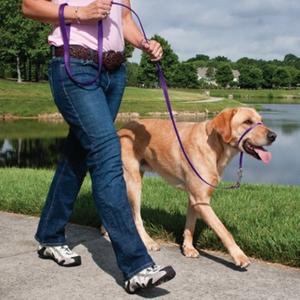Whether you’ve just added a new dog to your family, or you want to teach your old dog some new tricks, January is the perfect time to start training. In recognition of the Association of Professional Dog Trainers’ National Train Your Dog Month, PetSafe® Brand asked you to submit your questions to our team of certified trainers on Facebook. Below are answers to your most common training questions.
1. How do I train my dog to stop chewing?! She chews on blankets/bedding and toys.
While chewing is a natural and necessary behavior for your dog, it seems your dog is chewing on several items that it are inappropriate to chew on. Unfortunately, dogs often choose to chew on items that are valuable to us or could be dangerous for them. Your dog could be chewing for a variety of reasons including:
- Exploration or teething (if they are a puppy)
- Boredom
- Lack of exercise or enrichment
- Anxiety - You should consult your veterinarian or a trainer if you suspect the behavior could be triggered by fear or anxiety, like thunderstorm phobias or separation anxiety.
The safest and most effective way to begin training your dog will be to manage access to objects that are off limits. This is essential to keep your dog from continuing to chew on the items you don’t want him to destroy. This takes some effort on your part to pick up these items and place them in safe locations behind doors or out of reach. Doing so allows you to introduce items that are appropriate for chewing and begin 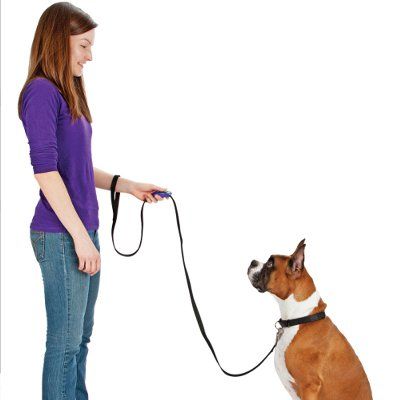 teaching your dog to chew these items instead.
teaching your dog to chew these items instead.
Providing a variety of chew toys for your dog can help in keeping him on his best behavior and save your couch, shoes, TV remotes, etc. Treat dispensing toys can be a good choice as they encourage the dog to chew the toy instead of something else. Keep in mind, no dog toy is indestructible! If they were truly indestructible they would be way too hard and could damage a dog’s teeth. Durable toys are however a much safer and appropriate choice than blankets, cell phones and other valuables! Always supervise your dog with the toy to determine how it holds up to your dog. If the toy becomes damaged replace it with a new toy. I know we want these toys to last forever but dog’s teeth are designed to rip, tear and crush. The best you can do is provide appropriate things for this fun activity and replace them when necessary!
You can also implement some additional training or activity to help keep inappropriate chewing at bay.
- Rotate your dog’s chew toys to increase variety
- Train a trade or drop cue to use when your dog has an inappropriate item
- Provide consistent exercise and/or playtime to alleviate boredom
Michelle Mullins, CPDT-KSA, KPA-CTP
2. Since we got a new dog, my Allie seems sad and depressed. The new dog takes all the attention and she won't even play ball anymore because he is faster than her. I thought I was doing something good by getting her a companion, but now I'm afraid I made a mistake.
Dogs brighten our life and bring us lots of laughter. Bringing another into the mix has the potential to make life more wonderful! Of course we want the new dog and current dog to hit it off immediately, but that doesn’t always happen. Making the transition from a one dog to a multiple dog household can be made easier with some preparation and ground work when the new dog arrives.
When you’re thinking of adding a new dog to the mix, consider the temperament of the dog you already have. Do you feel this dog would do well with a high energy dog or would he prefer a companion to lounge with? Is your dog more comfortable with smaller or larger dogs? Is your dog older and perhaps less interested in a bouncy puppy nipping and tugging at his ears? All of these types of questions can help you choose the type of dog you’re looking to add to your family.
After you have selected a new dog and brought him home, it is time to create a positive foundation. The first few interactions that the dogs have with each other should be:
- In an open space so that a dog can move away if he wants to
- Brief to avoid a dog getting overwhelmed and to give him a chance to recollect after the interaction
- Calm! Increased arousal can be overwhelming, especially as the dogs start to figure each other out
- Positive. Although it is possible to overcome a negative “first impression”, it is far easier just to ensure their first interactions with each other are enjoyable. Keep interactions with each other brief until they seem comfortable with each other.
After the foundation has been built, it is time to settle into a life together. Because dogs typically thrive on routine, your current dog might be surprised at the new addition. As your dog adjusts to the new addition, you might see some personality changes. As long as you keep interactions between the dogs positive and follow these tips, both dogs have a good chance of settling in nicely together.
The new dog will undoubtedly need to do some training to learn the new rules and culture of his new house. This can be simple lessons, such as learning about his new bed, or more complicated lessons, such as potty-training. Either way, this learning will impact how the dog interacts in the home and with the current dog. Understanding that and keeping both dogs comfortable and happy during this transition will go a long way.
Now that you have both dogs together, recognize that although the dogs live together, they may have very different personalities. Even if one dog is excitable, the other dog may still prefer lounging most of the day. It is important to let the dogs have space to be themselves without forcing the other to engage. This might mean a rowdy game of tug with one dog and a comfortable snuggle session on the couch with the other.
Try to spend time with each dog individually and when they are together. This shows the dogs that it is okay to be separated and that interactions can be positive when all together. It also shows the dog that they will get one-on-one time with you without having to share your attention. Forcing your current dog to suddenly share all of the games he used to enjoy playing alone might make him feel frustrated. Remember- he was once the only child and learning to share can be hard at first! On the other hand, you also want to make sure you are creating a safe and trusting environment for the new dog by spending time with him alone as well.
When adding a new dog, many people hope the two will play together. While some dogs start playing immediately, other dogs might take some time to develop a well-understood play session. It also might not end up looking like you thought it would. For example, if you anticipated your dog’s wrestling actively in the yard, you might be surprised to find that they ignore each outside but love playing a soft game of tug inside. It’s important to give the dogs space and time to figure out what type of play they enjoy together. Side note: you should always step in if you find that one dog is becoming overwhelmed during a play session.
Lastly, give them space. Some dogs will immediately snuggle up with each other, but other dogs prefer to have space until they can at least figure each other out. Avoid forcing them to share a small space, such as a crate or bed, until they are willingly participating in that activity without you.
Creating a multi-dog household can lead to an incredibly joyful life. Loyalty and companionship runs deep in our 4-legged pals and it is truly a wonderful thing to see and be a part of. With empathy, patience and a strong positive foundation, beautiful friendships can blossom between our pups.
Toni Mark, KPA-CTP
3. My family adopted an older dog from the shelter. He is kenneled at night. For the first couple of weeks, he was fine. But, with the past couple of days he’s started barking in the middle of the night. This can go on for over an hour at a time. What’s the best way to break him of this habit?
Congratulations on the new adoption. Getting a new dog to adjust to a new home can take time and lots of patience. It’s important to try and figure out why he/she is barking, the true source. Reasons can vary from needing to go out to the bathroom, not feeling well, to anxiety of being isolated. Dogs are social animals and really thrive on being with their people. Getting your pup used to the crate and realizing that he/she is only there temporarily is essential. Dogs bark to communicate with us that something is up, so it’s up to us to figure out what is bothering them. Below are a few tips to get your dog used to the crate and hopefully reducing the barking.
- Lack of exercise could also lead to the dog being more anxious in the crate. Make sure to provide the adequate amount of physical and mental exercise to your pup. Playing tug, fetch, jogging and nice long walks are great for physical exercise, but mental stimulation is also important. Busy Buddy toys provide enrichment and prevent boredom.
- Let your dog go in the crate during the day while everyone is in the house during the day for short periods of time. Provide him/her with a nice treat/kibble dispensing toy. The Kibble Nibble and Magic Mushroom are great options that will keep your dog engaged while in the crate. Your pup needs to associate being in the crate with positive things. Keeping the door open is important, so that the dog feels like it has a choice.
- For the initial adjustment with the new home, which could take even a few months, try moving the crate closer to the bedroom so the dog does not feel as isolated. As they get more comfortable and used to the home, you can slowly move the crate further and further.
- If the dog is not fully house trained, I would suggest opening the crate and letting the dog out to see if it did indeed need to eliminate. Even if the dog is house trained, it could have gotten into something and not be feeling well, still needing to go out. That might be why it was barking. (Only do this for a couple of days, if dog did not need to eliminate and just wants attention, then refrain giving him attention and taking him/her out) Ignore the behavior. Try putting some low, soothing music and covering the crate to calm your dog down.
- If the barking persists or worsens and your dog is showing signs of anxiety; drooling, shaking and lack of appetite and panic, then it could be separation anxiety. Separation anxiety problems can only be solved with counterconditioning and desensitization procedures. You may want to consult a professional animal-behavior specialist for help.
Rosalee Kaschel CPDT-KA
4. My daughter’s Chihuahua chews on her front paw all the way to her knee. Why would she do this? She's now 4 years old.
There are many possible reasons your daughter’s Chihuahua is chewing her paw and leg. Chewing of this type is a cause for concern. The chewing itself can cause discoloration, odor, and even infections if the skin is broken. You will want to consult your veterinarian about possible causes that include an injury or wound, allergies, yeast or bacteria. It could be one of these is an ongoing problem or caused the initial chewing which has now become a long term habit. Most of these causes are treatable and relief can be found with the right diagnosis and treatment from your veterinary professional.
Michelle Mullins CPDT-KSA, KPA-CTP
Thank you for submitting some great questions for our PetSafe Brand team of trainers during National Train Your Dog Month. You can find great additional resources at The Association of Pet Dog Trainers website www.trainyourdogmonth.com!



